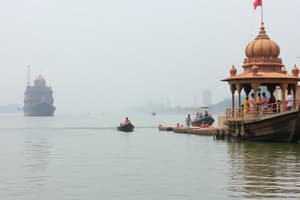Podcast
Questions and Answers
What is the approximate distance covered by the Ganges River?
What is the approximate distance covered by the Ganges River?
- 1,500 km
- 4,000 km
- 3,000 km
- 2,525 km (correct)
What is the largest tributary of the Ganges River?
What is the largest tributary of the Ganges River?
- Gomti
- Gandaki
- Yamuna River (correct)
- Ramganga
What is the main economic contribution of the Ganges River to agriculture?
What is the main economic contribution of the Ganges River to agriculture?
- Irrigation for rice and wheat crops (correct)
- Providing water for industries
- Supporting fisheries and aquaculture
- Generating hydroelectric power
What is the significance of the Ganges River in Hindu mythology?
What is the significance of the Ganges River in Hindu mythology?
What is the main environmental concern affecting the Ganges River?
What is the main environmental concern affecting the Ganges River?
What is the name of the program aimed at cleaning and restoring the Ganges River?
What is the name of the program aimed at cleaning and restoring the Ganges River?
What percentage of India's total power generation is accounted for by hydroelectric power?
What percentage of India's total power generation is accounted for by hydroelectric power?
What is the targeted hydroelectric power generation capacity by 2027 in India?
What is the targeted hydroelectric power generation capacity by 2027 in India?
What is the installed capacity of the Bhakra Dam in Himachal Pradesh?
What is the installed capacity of the Bhakra Dam in Himachal Pradesh?
What is the estimated hydroelectric power potential of India?
What is the estimated hydroelectric power potential of India?
What is the installed capacity of the Nathpa Jhakri Dam in Himachal Pradesh?
What is the installed capacity of the Nathpa Jhakri Dam in Himachal Pradesh?
What is the benefit of hydroelectric power generation in terms of climate change?
What is the benefit of hydroelectric power generation in terms of climate change?
What is the installed capacity of the Tehri Dam in Uttarakhand?
What is the installed capacity of the Tehri Dam in Uttarakhand?
What is the installed capacity of the Srisailam Dam in Andhra Pradesh?
What is the installed capacity of the Srisailam Dam in Andhra Pradesh?
Flashcards are hidden until you start studying
Study Notes
Ganges River
Location and Course
- Originates from the Gangotri Glacier in the Himalayas, Uttarakhand
- Flows through the states of Uttarakhand, Uttar Pradesh, Bihar, and West Bengal
- Covers a total distance of approximately 2,525 km (1,569 miles)
- Empties into the Bay of Bengal
Significance
- Considered the most sacred river in Hinduism
- Supports a large population and economy, including agriculture, industry, and fishing
- Plays a crucial role in Indian culture and spirituality
Tributaries
- Yamuna River: largest tributary, joins the Ganges at Allahabad (Triveni Sangam)
- Other notable tributaries: Ramganga, Gomti, Kosi, and Gandaki
Economic Importance
- Supports agriculture through irrigation, especially for rice and wheat crops
- Provides water for industries, such as textiles, paper, and sugar
- Fisheries and aquaculture are significant contributors to the economy
Environmental Concerns
- Pollution from industrial and human waste, agricultural runoff, and sewage
- Threats to biodiversity and ecosystem health
- Efforts underway to clean and restore the river, including the Namami Gange program
Cultural Significance
- Ganges River is personified as a goddess in Hindu mythology
- Considered a symbol of spiritual purification and salvation
- Many sacred cities and pilgrimage sites are located along the river, including Varanasi, Haridwar, and Rishikesh
Ganges River
- Originates from the Gangotri Glacier in the Himalayas, Uttarakhand
- Flows through four states: Uttarakhand, Uttar Pradesh, Bihar, and West Bengal
- Covers a total distance of approximately 2,525 km (1,569 miles) before emptying into the Bay of Bengal
Significance
- Considered the most sacred river in Hinduism
- Supports a large population and economy
- Plays a crucial role in Indian culture and spirituality
Tributaries
- Yamuna River is the largest tributary, joining the Ganges at Allahabad (Triveni Sangam)
- Other notable tributaries include Ramganga, Gomti, Kosi, and Gandaki
Economic Importance
- Supports agriculture through irrigation, especially for rice and wheat crops
- Provides water for industries such as textiles, paper, and sugar
- Fisheries and aquaculture are significant contributors to the economy
Environmental Concerns
- Pollution from industrial and human waste, agricultural runoff, and sewage
- Threats to biodiversity and ecosystem health
- Efforts underway to clean and restore the river, including the Namami Gange program
Cultural Significance
- Personified as a goddess in Hindu mythology
- Considered a symbol of spiritual purification and salvation
- Many sacred cities and pilgrimage sites are located along the river, including Varanasi, Haridwar, and Rishikesh
Hydroelectric Power in India
- India has an estimated 148,701 MW of hydroelectric power potential.
- Rivers in India are a significant source of hydroelectric power.
Major Hydroelectric Power Plants in India
- Bhakra Dam in Himachal Pradesh has an installed capacity of 1,325 MW.
- Nathpa Jhakri Dam in Himachal Pradesh has an installed capacity of 1,500 MW.
- Tehri Dam in Uttarakhand has an installed capacity of 1,000 MW.
- Srisailam Dam in Andhra Pradesh has an installed capacity of 1,670 MW.
Hydroelectric Power Generation in India
- India's total installed hydroelectric power generation capacity is over 45,000 MW.
- Hydroelectric power accounts for around 13% of India's total power generation.
- The government aims to achieve 200,000 MW of hydroelectric power generation capacity by 2027.
Benefits of Hydroelectric Power in India
- Hydroelectric power is a renewable and clean source of energy.
- It reduces dependence on fossil fuels, helping to mitigate climate change.
- It helps to regulate river flow and prevent floods.
- It creates employment opportunities in the energy sector.
Studying That Suits You
Use AI to generate personalized quizzes and flashcards to suit your learning preferences.




